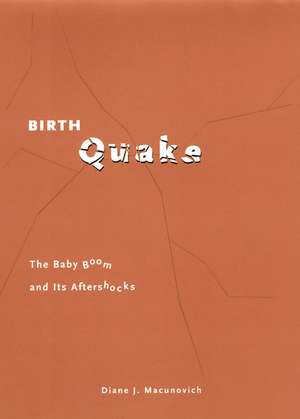Birth Quake: The Baby Boom and Its Aftershocks: Population and Development Series
Autor Diane J. Macunovichen Limba Engleză Hardback – 9 iun 2002
Between 1965 and 1985, the Western world and the United States in particular experienced a staggering amount of social and economic change. In Birth Quake, Diane J. Macunovich argues that the common thread underlying all these changes was the post-World War II baby boom—in particular, the passage of the baby boomers into young adulthood.
Macunovich focuses on the pervasive effects of changes in "relative cohort size," the ratio of young to middle-aged adults, as masses of young people tried to achieve the standard of living to which they had become accustomed in their parents' homes despite dramatic reductions in their earning potential relative to that of their parents. Macunovich presents the results of detailed empirical analyses that illustrate how varied and important cohort effects can be on a wide range of economic indicators, social factors, and even on more tumultuous events including the stock market crash of 1929, the "oil shock" of 1973, and the "Asian flu" of the 1990s. Birth Quake demonstrates that no discussion of business or economic trends can afford to ignore the effects of population.
Macunovich focuses on the pervasive effects of changes in "relative cohort size," the ratio of young to middle-aged adults, as masses of young people tried to achieve the standard of living to which they had become accustomed in their parents' homes despite dramatic reductions in their earning potential relative to that of their parents. Macunovich presents the results of detailed empirical analyses that illustrate how varied and important cohort effects can be on a wide range of economic indicators, social factors, and even on more tumultuous events including the stock market crash of 1929, the "oil shock" of 1973, and the "Asian flu" of the 1990s. Birth Quake demonstrates that no discussion of business or economic trends can afford to ignore the effects of population.
Preț: 332.59 lei
Preț vechi: 388.12 lei
-14% Nou
Puncte Express: 499
Preț estimativ în valută:
63.65€ • 65.18$ • 52.95£
63.65€ • 65.18$ • 52.95£
Carte indisponibilă temporar
Doresc să fiu notificat când acest titlu va fi disponibil:
Se trimite...
Preluare comenzi: 021 569.72.76
Specificații
ISBN-13: 9780226500836
ISBN-10: 0226500837
Pagini: 314
Ilustrații: 64 line drawings, 12 tables
Dimensiuni: 152 x 229 x 25 mm
Greutate: 0.58 kg
Ediția:1
Editura: University of Chicago Press
Colecția University of Chicago Press
Seria Population and Development Series
ISBN-10: 0226500837
Pagini: 314
Ilustrații: 64 line drawings, 12 tables
Dimensiuni: 152 x 229 x 25 mm
Greutate: 0.58 kg
Ediția:1
Editura: University of Chicago Press
Colecția University of Chicago Press
Seria Population and Development Series
Notă biografică
Diane J. Macunovich is a professor of economics at Barnard College.
Cuprins
Preface
Acknowledgments
Overview: The Birth Quake and Its Aftershocks
Part 1.Defining Concepts and Terms
1.Population Growth and Relative Cohort Size
2.Male Relative Income and Its Significance
3.Defining Variables: Relative Cohort Size and Relative Income
Part 2.First-Order Effects of Changing Relative Cohort Size
4.Patterns of Male Relative Income over the Years
5.First-Order Effects of Relative Cohort Size: Long-Term Trends
in Unemployment, Relative Income, and Returns to College
6.Effects of Relative Cohort Size on Inequality and the Overall
Structure of Wages
Part 3.Second-Order Effects of Changing Relative Cohort Size
7.Women's Roles: Labor Force Participation and the Emergence
of the "Career Woman"
8.Boom and Bust Cycles in College Enrollment Rates
9.Effects of Changing Male Relative Income on Marriage
and Divorce
10.The Dissappearance of the Marriage Wage Premium
11.Relative Cohort Size and Fertility: The Boom Turns into a Bust
12.Relative Cohort Size Effects—Even in Developing Countries
Part 4.Third-Order Effects of Changing Relative Cohort Size
13.Aggregated Demand Effects of Changing Population
Age Structure
14.Population-Induced Economic Slumps
15.Macroeconomic Correlations: GDP Growth, Inflation,
Saving Rates, and the Stock Market
16.Conclusion
Appendix A: Expectations in the Williams College Class of 1999
Appendix B: Data for Figure 4.1
Notes
References
Author Index
Subject Index
Acknowledgments
Overview: The Birth Quake and Its Aftershocks
Part 1.Defining Concepts and Terms
1.Population Growth and Relative Cohort Size
2.Male Relative Income and Its Significance
3.Defining Variables: Relative Cohort Size and Relative Income
Part 2.First-Order Effects of Changing Relative Cohort Size
4.Patterns of Male Relative Income over the Years
5.First-Order Effects of Relative Cohort Size: Long-Term Trends
in Unemployment, Relative Income, and Returns to College
6.Effects of Relative Cohort Size on Inequality and the Overall
Structure of Wages
Part 3.Second-Order Effects of Changing Relative Cohort Size
7.Women's Roles: Labor Force Participation and the Emergence
of the "Career Woman"
8.Boom and Bust Cycles in College Enrollment Rates
9.Effects of Changing Male Relative Income on Marriage
and Divorce
10.The Dissappearance of the Marriage Wage Premium
11.Relative Cohort Size and Fertility: The Boom Turns into a Bust
12.Relative Cohort Size Effects—Even in Developing Countries
Part 4.Third-Order Effects of Changing Relative Cohort Size
13.Aggregated Demand Effects of Changing Population
Age Structure
14.Population-Induced Economic Slumps
15.Macroeconomic Correlations: GDP Growth, Inflation,
Saving Rates, and the Stock Market
16.Conclusion
Appendix A: Expectations in the Williams College Class of 1999
Appendix B: Data for Figure 4.1
Notes
References
Author Index
Subject Index







